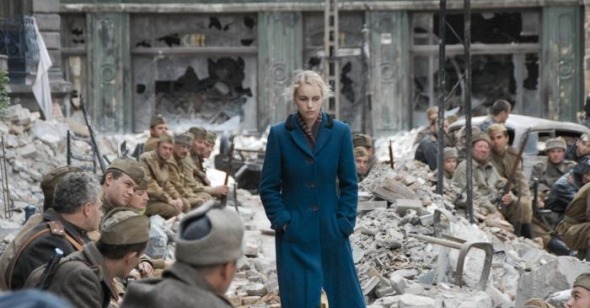A Greater Power
by Chris Wisniewski
A Woman in Berlin
Dir. Max Farberbock, Germany, Strand
Director Max Farberbock, who received international recognition for the lesbian romance Aimee & Jaguar, returns to mid-1940s war-torn Berlin for his latest film. Adapted from a diary that was published anonymously in the 1950s, A Woman in Berlin begins at the tail end of World War II, as the Soviets take control of the city. Occupation is the film’s literal and figurative subject. Its anonymous protagonist (“Anonyme,” Nina Hoss), a former journalist, is raped repeatedly by her Soviet occupiers, like many of her female friends and neighbors. Hungry, desperate, and fortunate enough to speak a little bit of Russian, she decides to use her sexuality to her advantage, targeting men to take as partners in an attempt to secure food, safety, and other amenities. She realizes that this quid pro quo makes her something of a prostitute (“A whore?” she wonders in her diary. “Perhaps”), but she also knows that she has no other power to wield—she can either accept her victimization or turn it to her advantage.
As the film’s closing intertitles note, the initial publication of the diary in Germany stirred controversy on the charge that it represented an affront to the honor of German women. The complaint may seem outrageous in hindsight, but it’s easy to imagine a nation just 15 years out of a militarily and morally crushing war rejecting a book that exposed the extremity of its powerlessness at the end of the conflict—and the price paid by its citizens as a result. The atrocities of military occupation make neither the occupier nor the occupied look good, and so it makes sense that they are frequently elided in the short term. It was only after the author’s death earlier this decade that A Woman in Berlin was reissued in Germany, to widespread acclaim. Taken in this context, Farberbock’s film is more than a simple period piece; it’s also an excavation of a largely ignored historical trauma.
Farberbock wisely ignores the larger political context for his historical drama. Hitler, Mussolini, and Stalin are mentioned in passing, as are fascism and central planning, but these references almost function as red (ahem) herrings. A Woman in Berlin takes place in a moment and setting where ideology and ethics begin to dissolve in the face of suffering and brutality. Labels like prostitution and propriety hardly matter in the circumstances that confront Anonyme, played by Hoss with a quiet, focused resolve; she is guided instead by a more primal survival instinct. Her decision to use sex is simply a cunning calculation—a way to turn her limited Russian and sex appeal into assets in a postwar war zone—rather than an act of moral compromise or political defeat. And she is not alone in making this calculation.
The movie never reaches for metaphors or strains to make social or historical commentary, instead taking a more personal and subjective approach. Anonyme narrates the film in voiceover, and even when it strays from her perspective, Farberbock's handheld camerawork, a preponderance of following shots, and a tendency towards naturalistic lighting reflect a commitment to a trendy brand of realism. But Farberbock either lacks the rigor of a Cuarón or a Spielberg or simply recognizes the need for some restraint in his approach. He occasionally relents from his submersing aesthetic with cutaways and elliptical fades. Given the movie's subject matter, they're something of a blessing: The rapes are depicted with an appropriate level of tastefulness, neither ignoring nor exploiting their violence, and the emphasis is placed more on their psychological impact than their visceral effect. In one rape scene, the perpetrator spits, in close-up, onto Anonyme's face. The degradation of the act packs nearly as much of an emotional punch as more explicit moments of physical brutality. Indeed, Farberbock manages to strike just the right tone in the film's first half, dramatically and visually. Though there are fiercely kinetic outbursts of violence, the director establishes mood largely through his depiction of life in the rubble-strewn streets of Berlin. His widescreen, wide-angle compositions survey the devastation of the city, exquisitely rendered by production designers Andrzej Halinski and Uli Hanisch, with elegance and a keen attention to detail.
Once Farberbock succeeds in establishing a sense of place and the stakes of his central premise, the movie makes a turn towards the conventional, as Anonyme takes a lover (Roman Gribkov) and develops an increasingly romantic attachment to a Russian major (Yevgeni Sidikhin). The romantic triangle setup becomes an "impossible love"–style melodrama that proves far less affecting or engaging than the emotionally gripping, though bleak, material that precedes it, and most of the plot twists that follow (a suicide, a fiancé back from the front) are frustratingly obvious. The love story subtext is also a questionable change of emphasis from the film's first half (and also its source material). A Woman in Berlin spends so much time establishing and investigating a circumstance under which sex and sexuality become completely alienated from love and romance, where women are forced to think of their bodies as assets they may trade, leverage, and barter, that it's hard to hear Anonyme then explain, “I can’t really say the major rapes me. I am at his disposal.” A Woman in Berlin is never anything less than sensitive and finely crafted, but what begins as an attempt to tell a story that has remained untold for over 50 years becomes, quite simply, a well-made genre picture.
